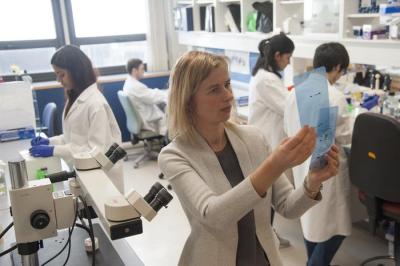
CALEC trial principal investigator Ula Jurkunas, MD, associate director of the Cornea Service at Mass Eye and Ear and professor of Ophthalmology at Harvard Medical School, in her laboratory. Image credit: Mass Eye and Ear.
An expanded clinical trial that tested a groundbreaking, experimental stem cell treatment for blinding cornea injuries found the treatment was feasible and safe in 14 patients who were treated and followed for 18 months, and there was a high proportion of complete or partial success. The results of this new phase 1/2 trial are published in Nature Communications.
The treatment, called cultivated autologous limbal epithelial cells (CALEC), was developed at Mass Eye and Ear. The innovative procedure consists of removing stem cells from a healthy eye with a biopsy, expanding them into a cellular tissue graft in a novel manufacturing process that takes two to three weeks, and then surgically transplanting the graft into the eye with a damaged cornea.
Researchers showed CALEC completely restored the cornea in 50% of participants at their 3-month visit and that rate of complete success increased to 79% and 77% at their 12- and 18-month visits, respectively.
With two participants meeting the definition of partial success at 12 and 18 months, the overall success of CALEC was 93% and 92% at 12 and 18 months. Three participants received a second CALEC transplant, one of whom reached complete success by the study end visit. An additional analysis of CALEC’s impact on vision showed varying levels of improvement of visual acuity in all 14 CALEC patients.
CALEC displayed a high safety profile, with no serious events occurring in either the donor or recipient eyes.